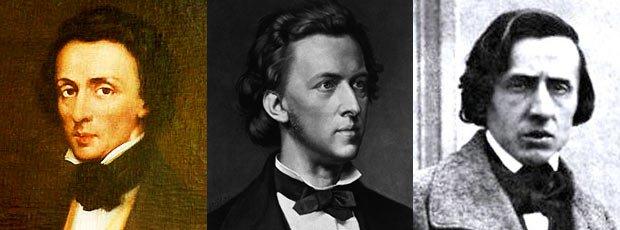Chopin embodies the Romantic ideal of the introverted and reclusive genius. His music is full of unexpected twists and turns, and explores the full range of Romantic expression through the piano.
Vital Statistics
Born:
March 1, 1810, near Warsaw, Poland
Died:
October 17, 1849, Paris
During Lifetime:
Poland struggled for independence from Russia. Artistic contemporaries: Hector Berlioz, Franz Liszt, Felix Mendelssohn, painter Eugene Delacroix, author George Sand.
Biographical Outline
Polish at heart : Chopin grows up in Poland, but his talents quickly outgrow what the Warsaw musical scene can offer him. He emigrates to France in 1831, but remains Polish to the core. Chopin writes the first of his mazurkas (Polish dances) in Vienna in 1830, when the first Warsaw uprising took place, and becomes even more conscious of his national identity after that.Making a splash, 1832 : Chopin arrives in Paris when sympathy for the Polish cause is high. His first concert is well-reviewed, and he catches the attention of the younger generation of musicians in the city, like Berlioz and Liszt. High society : Chopin quickly expands his social connections, and from late 1832 on he rarely appears in public concerts. His income derives from teaching, for which he charges a princely sum, as well as performances at salons. (Salons were private gatherings at which art, philosophy, and ideas might be discussed. Most were hosted by socially connected women.) After 1833 his income is bolstered by publication of his music.Liaison : In 1838, Chopin and the novelist George Sand (her real name was Amarice Dupin) become lovers. They spend the winter in Majorca, where Chopin’s tuberculosis is first diagnosed. Hunkering down, 1840s : Introverted and sickly, Chopin secludes himself in a small circle of friends and artists, including Mendelssohn, Berlioz, the painter Eugene Delacroix, and the poet Heinrich Heine. He spends summers at Sand’s manor house, until their relationship ends in 1846. Decline : Chopin takes an ill-advised trip to London and Scotland in 1848, at the invitation of his pupil Julie Stirling. He makes little money there, however, and his health worsens. He returns to Paris, dying, and is attended by his sister, Ludwika, and her family.Last written words, age 39 : "As this cough will choke me, I implore you to have my body opened, so that I may not be buried alive."
Fun Facts
I left my heart in Warsaw : Although he was buried in Paris, Chopin’s heart was removed and buried in Poland. To this day, Chopin is still revered in Poland as one of the country’s great cultural heroes.A true Romantic : Chopin had a seductively otherworldly air, and loved intellectual company and high society. He could also be cold, petty, and arrogant.In film : Chopin has been the subject of several movies: A Song to Remember (1945), with Cornell Wilde as Chopin and Merle Oberon as Sand, is an Old Hollywood classic, and was nominated for six Oscars. James Lapine’s independent film Impromptu (1991), with Hugh Grant and Judy Davis in the leads, is more detailed and less idealized. A Polish version of this story is Chopin: Desire for Love (2002).In his own words : "Sometimes I can only groan, and suffer, and pour out my despair at the piano!"
Recommended Biography
Jim Samson, Chopin (Oxford, 1996).
Explore the Music
Chopin composed largely for the piano. His early style, as in his two concertos and the Grande polonaise brillante, is virtuoso-brilliant, but as he matured, he wrote much more carefully, with incredible attention to detail. While many of his later works are in fashionable salon forms (études, dances, ballades), he virtually reinvented these genres for his own purposes.
Recommended Websites
look inside Nocturnes (Piano Solo). By Frederic Chopin (1810-1849). Edited by Rafael Joseffy. For solo piano. Piano Collection. Romantic Period. SMP Level 10 (Advanced). Collection. Fingerings and introductory text (does not include words to the songs). 96 pages. G. Schirmer #LB30. Published by G. Schirmer (HL.50252200) ...more info
Recordings
Piano Concertos 1 and 2 Martha Argerich; London Symphony/Claudio Abbado (DG, 1996) Murray Perahia; Israel Philharmonic/Zubin Mehta (Sony, 1990) Also look for Krystian Zimerman’s recording with Carlo Maria Giulini and the Los Angeles Philharmonic (DG) now only available on a complete works collection. Andante spianato and Grande polonaise brillante :Malcolm Frager (Telarc, 2003). Also includes other early works, the Sonata No. 3, and the “Heroic” Polonaise, No. 6. Piano sonatas Nos. 2 and 3 :Martha Argerich (DG 1987) Murray Perahia (Sony/CBS 1990) Anton Rubinstein. The Rubinstein Collection, Vol. 46 (RCA, 2001) The Four Ballades and the Four Scherzos :The Four Impromptus :Murray Perahia (Sony, 1990) Claudio Arrau (2 discs, Philips, 1997) 24 Preludes , Op. 28 and C-Sharp Minor Prelude, Op. 45Martha Argerich (DG, 1991) Nocturnes: Ivan Moravec (Nonesuch, 1991) Artur Rubinstein (RCA, 2000) Shorter Works : Although the shorter works are normally, recorded by genre, a varied program actually makes for better listening. Below are some excellent Chopin discs with selections of the shorter works:Chopin: Ballades, Mazurkas, Polonaises, Piotr Andreszewski (EMI 2004). Includes three later polonaises (Opp. 44, 52, 53) and the later mazurkas (Opp. 59 and 63, and 68/4). Martha Argerich: The Legendary 1965 Recording. (EMI, 1999). One of the great Chopin interpreters of the last 40 years caught in the year that Argerich won the Warsaw International Chopin Competition. Includes many favorite works.Favorite Chopin, Vladimir Ashkenazy. 2 CDs (London, 1996)
